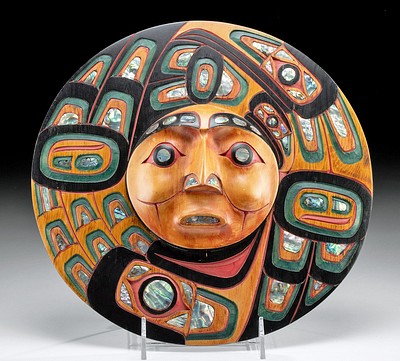Early Burmese Mandalay Gilded Buddha Lotus Position
Lot 103
About Seller
Artemis Gallery
686 S Taylor Ave, Ste 106
Louisville, CO 80027
United States
Selling antiquities, ancient and ethnographic art online since 1993, Artemis Gallery specializes in Classical Antiquities (Egyptian, Greek, Roman, Near Eastern), Asian, Pre-Columbian, African / Tribal / Oceanographic art. Our extensive inventory includes pottery, stone, metal, wood, glass and textil...Read more
Categories
Estimate:
$2,000 - $2,500
Absentee vs Live bid
Two ways to bid:
- Leave a max absentee bid and the platform will bid on your behalf up to your maximum bid during the live auction.
- Bid live during the auction and your bids will be submitted real-time to the auctioneer.
Bid Increments
| Price | Bid Increment |
|---|---|
| $0 | $25 |
| $300 | $50 |
| $1,000 | $100 |
| $2,000 | $250 |
| $5,000 | $500 |
| $10,000 | $1,000 |
| $20,000 | $2,500 |
| $50,000 | $5,000 |
| $100,000 | $10,000 |
| $200,000 | $20,000 |
About Auction
By Artemis Gallery
Dec 7, 2023
Set Reminder
2023-12-07 10:00:00
2023-12-07 10:00:00
America/New_York
Bidsquare
Bidsquare : Fine Antiquities, Ancient & Pre-Columbian Art
https://www.bidsquare.com/auctions/artemis-gallery/fine-antiquities-ancient-pre-columbian-art-14361
Classical antiquities, ancient, and ethnographic art from cultures encompassing the globe. Egyptian, Greek, Roman, Etruscan, Near Eastern, Asian, Pre-Columbian, Native American, African / Tribal, Oceanic, Spanish Colonial, Fine / Visual Arts, so much more! Artemis Gallery info@artemisgallery.com
Classical antiquities, ancient, and ethnographic art from cultures encompassing the globe. Egyptian, Greek, Roman, Etruscan, Near Eastern, Asian, Pre-Columbian, Native American, African / Tribal, Oceanic, Spanish Colonial, Fine / Visual Arts, so much more! Artemis Gallery info@artemisgallery.com
- Lot Description
Southeast Asia, Burma (Myanmar), ca. late 19th to early 20th century CE. A beautiful cast brass Buddha in the Mandalay style with shimmering inlays of glass and painted with gold hues. The eyes are inlaid with enamel that adds a lifelike quality to the visage. He is seated on an integral pedestal in full lotus position, his hands forming the earth witness mudra gesture, his right hand resting on his knee reaching towards the ground, and his other hand in his lap. The underside reveals the hollow casting technique, and much of the interior cavity is filled with stucco or stone material from where this beautiful statue once rested. Size: 17" L x 10" W x 21" H (43.2 cm x 25.4 cm x 53.3 cm); gold quality: 14.21% to 17.67% (equivalent to 3K+ to 4K+)
The Buddha displays the Calling Earth to Witness mudra, also known as Subduing Mara or Bhumisparsa representing the moment just prior to enlightenment, with the Buddha sitting in meditation, his left hand in his lap with palm upright, and his right hand palm downward touching the earth. At the moment just before Siddhartha Gautama attained enlightenment, the demon Mara viciously attacked him with his troops of monsters attempting to scare him away from his seat under the bodhi tree. However, the Buddha-to-be remained. Mara claimed that his spiritual deeds were greater than Siddhartha’s challenging the Buddha-to-be. Then Siddhartha extended his right hand to touch the earth, Mara disappeared, and Siddhartha achieved enlightenment.
Provenance: private Rochester, Michigan, USA collection
All items legal to buy/sell under U.S. Statute covering cultural patrimony Code 2600, CHAPTER 14, and are guaranteed to be as described or your money back.
A Certificate of Authenticity will accompany all winning bids.
We ship worldwide and handle all shipping in-house for your convenience.
#182605Losses to glass inlays on head. Surface has probably been gilt and painted several times, with fading and uneven surface coloration. Minor loss to brass edge on base, but rest of statue is intact with surface abrasions and chips to pigments. Heavy mortar remains inside the hollow body.Condition
- Shipping Info
-
All shipping is handled in-house for your convenience. Your invoice from Artemis Gallery will include shipping calculation instructions. If in doubt, please inquire BEFORE bidding for estimated shipping costs for individual items.
-
- Buyer's Premium



 EUR
EUR CAD
CAD AUD
AUD GBP
GBP MXN
MXN HKD
HKD CNY
CNY MYR
MYR SEK
SEK SGD
SGD CHF
CHF THB
THB















